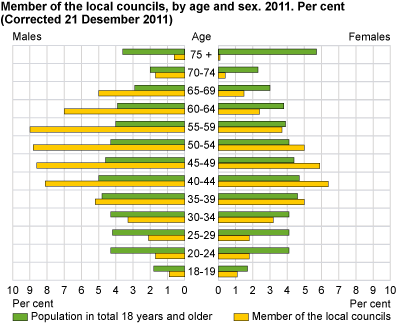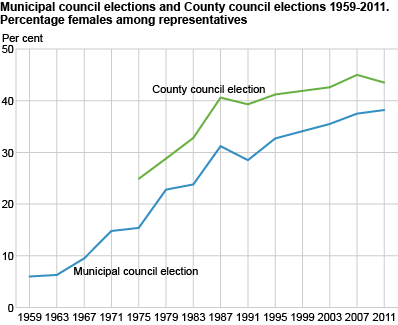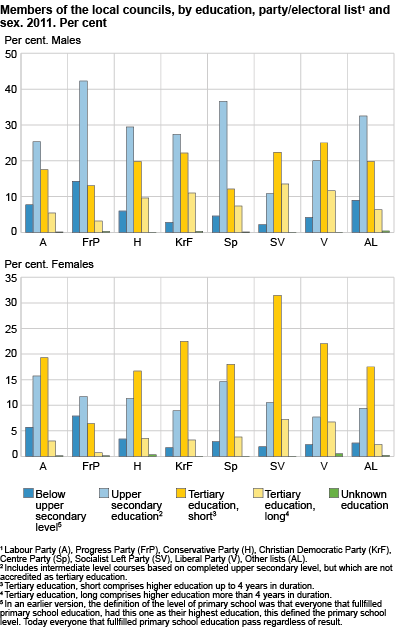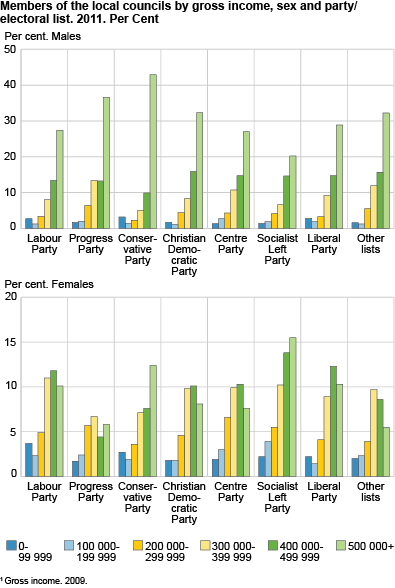Content
Published:
This is an archived release.
No increase in female representation [Corrected 20.12.2011]
Total number of female chairmen and representatives is stable compared to 2007. A somewhat larger share of the elected members to the municipal councils was immigrants in the 2011 election compared to the previous one in 2007. 42 per cent of all the representatives have an income above NOK 500 000.
Compared to the election in 2007 the proportion of female representatives is stable, about 38 per cent. The Socialist Left Party is the only party where women make up more than half of the representatives - 51 per cent, followed by the Labour Party with 44 per cent. In the Progress Party the proportion of women is - as in the last election - lowest of all the mayor parties with 27 per cent.
Stable proportion of female chairmen
The chairmen election resulted in 96 female chairmen, compared to 97 in 2007. Female chairmen now account for 22 per cent of all chairmen. The Labour Party has most in total with 34 followed by the Conservative Party with 32.
2.5 per cent of the representatives are immigrants
In total, 268 immigrants were elected to the municipal councils. This is an increase of 45 representatives since the previous election. These representatives accounts for 2.5 per cent of the total number of representatives compared to 2 per cent in the 2007 election. 68 per cent, or 180, were from Asia, Africa, Latin-America and Europe except EU/EEA, while 88 were fromthe EU/EEA, Northern America and Oceania.
Still underrepresented
Even if the representatives with an immigrant background still are underrepresented, this election brings a result were there is a certain better accordance between the total share of representatives and the total number of persons entitled to vote, than in 2007.
With 5 per cent, the Socialist Left Party has the largest share of representatives with an immigrant background, followed by the Labour Party with 4 per cent and the Conservative Party with 2 per cent. In contrast, the Centre Party has the least share of all the parties with 0.4 per cent. The Labour Party and the Conservatives see an increase of 1 percentage points in representatives with an immigrant background, while the share has decreased with 2 percentage points in the Socialist Left Party.
Males aged 40 to 59 years dominates
There is an uneven representation of age groups in municipal councils. The dominating age groups are 40-49 years and 50-59 years, accounting for 29 and 26 per cent of the representatives each, while they account for 19 and 17 per cent respectively of the people entitled to vote in these groups. Men aged 40-59 represent 35 per cent of the elected representatives, but only 18 per cent of those eligible to vote. Women aged 60 and above are underrepresented, as are people below 30 years of age with 4 and 5 per cent of the representatives, respectively. Compared to the election in 2007, there is minor changes in the representatives age composition, but still, a minor increase in the share of the representatives aged 60 and above and people below 30 can be observed.
The Conservative Party won most new chairmen, the Labour Party lost most
Of the major parties only the Conservative Party and the Centre Party have increased their proportion of total number of chairmen compared to the 2007 election. The Conservative Party won most new chairmen with 44, and now has 119. The Conservative Party now passed the Centre Party as the party with the second most chairmen in total. The Labour Party lost most with 25 compared to 2007, but still has most chairmen with 154. The Centre Party won three new chairmen and now has 86. Local lists now have 17 chairmen compared to 8 in 2007.
The government coalition parties together have 57 per cent of the chairmen, compared to 62 per cent in the last election. The opposition parties have 153 chairmen, or about 36 per cent - an increase of 7 percentage points from 2007.
Female representatives with higher education
Nearly 50 per cent of the representatives have completed a degree in higher education. The female representatives generally have a higher education level than the male representatives. In total, 55 per cent of the female representatives have completed a degree in higher education, compared to 41 per cent of the males.
Among the parties, the representatives from the Socialist Party differ from the other mayor parties with the largest part of the representatives with an degree in higher education: in total 75 per cent. Progress Party had 23 per cent representatives with higher education.
More representatives with high income
In general, the level of income has increased since the election in 2007 - which also is reflected in the income level of the elected representatives. The proportion of the representatives with an income above NOK 500 000, has increased to constitute 42 per cent of the total. Compared to 2007, this proportion has increased with 19 percentage points.
Tables:
- Table 1 Chairmen, by party and county. 2011
- Table 2 Deputy chairmen, by party and county. 2011
- Table 3 Number of municipalities, by party, chairmen and deputy chairmen. 2011. The whole country
- Table 4 Female chairmen, by party and county. 2011
- Table 5 Female deputy chairmen, by party and county. 2011
- Table 6 Members and re-elected members of the local councils, by county. 2011
- Table 7 Chairman and deputy chairman of the county councils. Name and party, by county. 2011
- Table 8 Members and re-elected members of the executive commitee of local councils, by sex and party/electoral lists. 2011
- Table 9 Members of the executive committee of county councils, by party and county. 2011
- Table 10 Members of county councils, by party and county. 2011
- Table 11 Members of the executive committee of the county councils and re-elected members, by county. 2011
- Table 12 Members of the executive committee of local councils, by parti and municipality. 2011
- Table 13 Members of the local councils, by party and municipality. 2011
- Table 14 Chairmen/deputy chairmen 2011. Spesification of Joint lists (FL), Local list (LL) and Other lists (AL)
- Table 15 Members and re-elected members, by sex and party/electoral list. 2011
- Table 16 Member of the local councils, by party/electoral list, age and sex. 2011. The whole country. Per cent
- Table 17 Member of the local councils, by age and sex. 2011. The whole country
- Table 18 Member of the local councils, by age, sex and county. 2011. Per Cent
- Table 19 Member of the county councils, by age and sex. 2011. The whole country
- Table 20 Members of the local councils, by industry, sex and region. 2011. Per Cent
- Table 21 Members of the local councils, by party, industry and sex. 2011. Per Cent
- Table 22 Members of the local councils, by level of occupation, sex and region. 2011
- Table 23 Members of the local councils by, party, level of occupation and sex. 2011. Per Cent
- Table 24 Members of the local councils, by immigration background and region. 2011
- Table 25 Members of the local councils, by immigration background and party1. 2011
- Table 26 Members of the local councils, by education, party and sex. 2011
- Table 27 Members of the local councils, by education, sex and region. 2011
- Table 28 Members of the local councils by gross income, sex and region. 2011
- Table 29 Members of the local councils by gross income, sex and party/electoral list. 2011. Per cent
- Table 30 Chairmen and, Deputy chairmen by party/electoral list and municipality. 2011
- Table 31 Municipal council elections 2007-2011. Valid votes and representatives, by party/electoral list
- Table 32 County council elections 2007-2011. Valid votes and representatives, by party/electoral list
- Table 33 Municipal council elections 1991-2011. Representatives and percentage females among representatives, by county
- Table 34 County council elections 1995-2011. Representatives and percentage females among representatives, by county
- Table 35 Municipal council election 2011. Representatives by party/electoral list , by municipality
- Table 36 Municipal council election 2011. Female representatives, by party1 and municipality. Percentage
- Table 37 County council election 2011. Representatives by party, by municipality
- Table 38 Municipal council election 2011. Nominees, representatives and deputy representatives, by municipality. Percentage of females
This page has been discontinued, see Municipal and county council election, candidates and representatives, Every four years, candidates.
Find more figures
Find detailed figures from Municipal and county council election, candidates and representatives
Contact
-
Øyvin Kleven
E-mail: oyvin.kleven@ssb.no
tel.: (+47) 45 88 89 37
-
Statistics Norway's Information Centre
E-mail: informasjon@ssb.no
tel.: (+47) 21 09 46 42
-
Tove Bergseteren
E-mail: tove.bergseteren@ssb.no
tel.: (+47) 99 79 08 19




